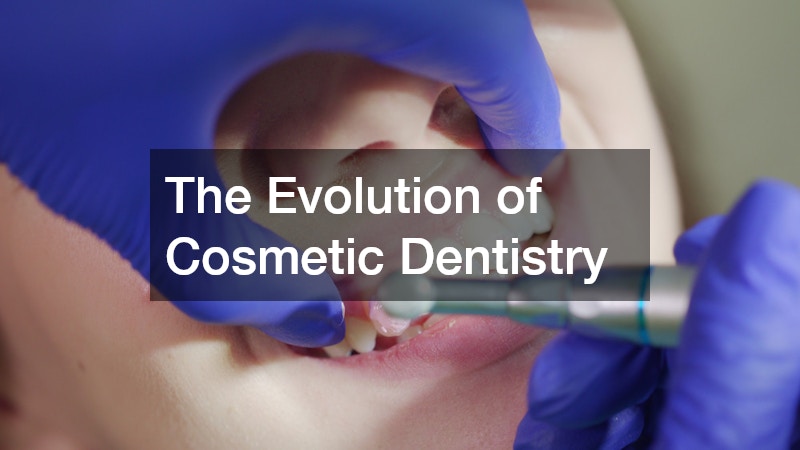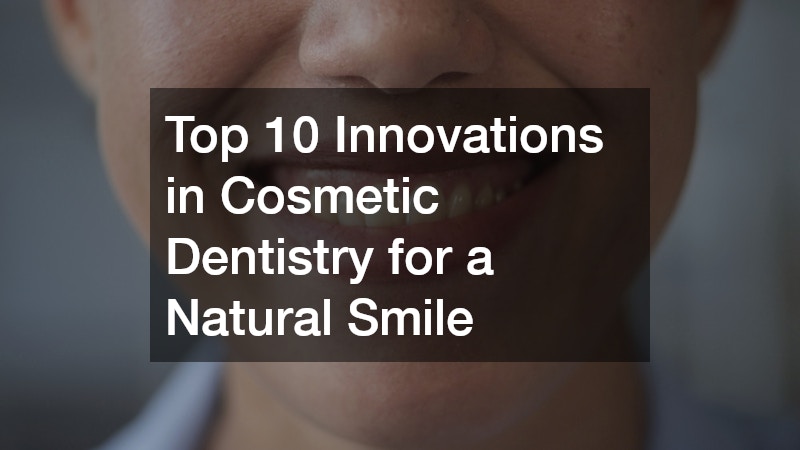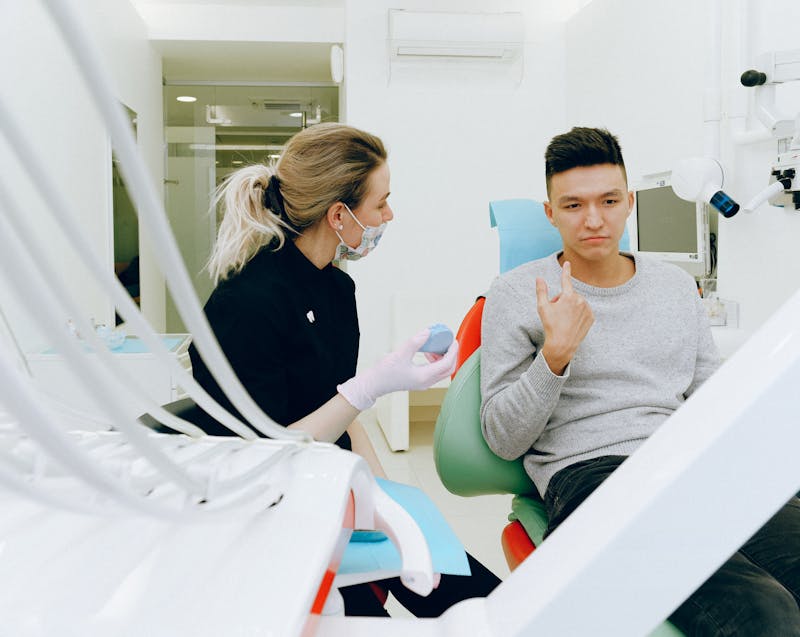
- Digital Smile Design enhances treatment planning by visualizing outcomes before procedures begin.
- 3D printing allows for precise and efficient creation of dental restorations.
- Advanced materials like ceramics and composites offer natural-looking and durable solutions.
- Laser dentistry enables minimally invasive procedures with reduced discomfort.
- Clear aligners provide a discreet orthodontic option for adults.
- Biomimetic dentistry focuses on restoring teeth to their natural form and function.
- AI-assisted diagnostics lead to more accurate and personalized treatment plans.
Introduction – The Evolution of Cosmetic Dentistry

Cosmetic dentistry has experienced remarkable advancements in recent years, driven by technological innovations and a growing emphasis on aesthetic outcomes. According to the American Academy of Cosmetic Dentistry (AACD), the demand for cosmetic dental procedures has increased by over 200% in the past decade, reflecting a significant shift towards prioritizing dental aesthetics Woodland Dental Center.
This surge in popularity underscores the importance of staying informed about the latest developments in the field. For individuals seeking to enhance their smiles, consulting with the Top 10 dentists renowned for their expertise in cosmetic procedures can provide invaluable insights and personalized treatment options.
The Importance of Innovation in Cosmetic Dentistry
Innovation is essential in cosmetic dentistry for several reasons:
-
Enhanced patient outcomes: Advanced tools and techniques allow dentists to achieve results that are more precise, natural-looking, and long-lasting.
-
Minimally invasive procedures: Many innovations reduce the need for extensive drilling, extractions, or multiple visits, preserving more natural tooth structure.
-
Predictable results: Modern digital tools enable dentists to plan and simulate outcomes before treatment begins.
-
Patient education and confidence: Patients can visualize results, understand the process, and make informed decisions about their care.
By incorporating these innovations, cosmetic dentistry has moved beyond a one-size-fits-all approach to highly personalized treatments that combine science and artistry.
Top 10 Innovations Driving Natural Smile Transformations
1. Digital Smile Design (DSD)
Digital Smile Design is revolutionizing the way dentists plan cosmetic procedures. Using advanced imaging software and 3D modeling, DSD allows both patients and dentists to visualize the expected outcome before treatment begins.
Key benefits of DSD include:
-
Accurate simulation of veneers, crowns, and orthodontic outcomes.
-
Customization of smile shape, tooth length, and spacing to match facial features.
-
Improved communication between dentist, lab technicians, and patients.
-
Predictable results that reduce the risk of dissatisfaction.
How DSD Ensures a Natural Look:
-
Considers the proportion and symmetry of teeth relative to the face.
-
Allows virtual testing of tooth color and translucency.
-
Integrates patient feedback to refine the design before any physical work is done.
Tip: Patients can request a digital mockup of their proposed smile to ensure expectations align with achievable results.
2. 3D Printing for Restorations
3D printing has become a game-changer in producing crowns, bridges, dentures, and clear aligners with unprecedented accuracy. This technology allows dental laboratories to fabricate highly detailed restorations quickly and efficiently.
Benefits of 3D Printing in Cosmetic Dentistry:
-
Faster production times compared to traditional lab methods.
-
Highly precise restorations that fit perfectly and require minimal adjustments.
-
Cost-effective solutions due to reduced material waste.
-
Ability to produce temporary and permanent restorations in a single workflow.
Future Potential:
-
In-office 3D printers enable same-day restorations.
-
Biocompatible resins and metals can mimic natural tooth structures more realistically.
-
Integration with digital scanning ensures a fully customized fit.
Tip: Ask your dentist if your restoration can be designed and printed digitally for maximum accuracy and comfort.
3. Advanced Ceramic and Composite Materials
Modern cosmetic dentistry relies heavily on high-quality materials that replicate the natural look and feel of teeth.
Ceramic Innovations:
-
Lithium Disilicate: Known for translucency and strength, ideal for crowns and veneers.
-
Zirconia-based ceramics: Extremely durable, resistant to cracking, and can mimic natural tooth shades.
Composite Innovations:
-
Nano-composites allow sculpting with fine detail for natural textures.
-
Biocompatible resins reduce the risk of allergies or sensitivity.
Benefits:
-
Enhanced aesthetic appeal due to natural translucency.
-
Long-lasting and resistant to staining.
-
Can be used in combination with veneers, crowns, and bonding procedures for optimal results.
Tip: Discuss material options with your dentist to select a combination that balances aesthetics, durability, and cost.
4. Laser Dentistry for Precision and Comfort
Laser technology is increasingly used in cosmetic dentistry for procedures that require soft-tissue precision, whitening, or minimally invasive interventions.
Applications of Lasers:
-
Gum contouring and reshaping.
-
Teeth whitening procedures.
-
Removal of decay in early stages without extensive drilling.
Benefits:
-
Minimizes discomfort, swelling, and bleeding.
-
Promotes faster healing and reduces infection risk.
-
Allows dentists to work with extreme precision, preserving more natural tooth structure.
Tip: Ask if laser technology is available for gum reshaping or whitening, as it often results in a more comfortable and predictable experience.
5. Minimally Invasive Veneers (Lumineers & Ultrathin Options)
Traditional veneers require the removal of some enamel, which can affect the natural strength of teeth. Modern ultrathin veneers or no-prep veneers have addressed this concern.
Advantages:
-
Minimal or no enamel removal preserves natural teeth.
-
Achieves natural translucency and tooth color.
-
Shorter procedure time and reduced sensitivity.
Key Applications:
-
Correcting minor chips, discoloration, or misalignment.
-
Creating a harmonious smile without invasive procedures.
Tip: Patients with healthy enamel who want subtle aesthetic improvements may benefit from ultrathin veneers.
6. Clear Aligners and Invisible Orthodontics
Orthodontic treatment has evolved far beyond metal braces. Clear aligners offer a discreet solution to teeth misalignment while complementing cosmetic dental treatments.
Benefits:
-
Virtually invisible, increasing patient confidence during treatment.
-
Removable for eating and cleaning, improving oral hygiene.
-
Designed using digital scans for precise tooth movement.
Applications in Cosmetic Dentistry:
-
Aligners prepare teeth for veneers or bonding by correcting positioning first.
-
Combined with whitening or contouring to enhance overall smile aesthetics.
Tip: Discuss clear aligner options for gradual, non-invasive corrections before undertaking major cosmetic procedures.
7. Teeth Whitening Innovations with LED and Laser Systems
Teeth whitening has become safer, faster, and more effective thanks to modern light-activated systems.
Modern Whitening Approaches:
-
LED-activated gels accelerate bleaching with less enamel sensitivity.
-
Laser-assisted whitening reduces treatment time and enhances results.
-
Hybrid systems combine in-office procedures with take-home kits for maintenance.
Benefits:
-
Brighter, natural-looking teeth without over-whitening.
-
Reduced sensitivity compared to older whitening techniques.
-
Can be combined with other cosmetic treatments for full smile rejuvenation.
Tip: Patients should consult with their dentist to select a whitening method suitable for their enamel and oral health.
8. Biomimetic Dentistry – Restoring Teeth Naturally
Biomimetic dentistry focuses on mimicking natural tooth structure and function rather than just replacing damaged teeth.
Principles:
-
Use of adhesives and flexible materials to replicate enamel and dentin behavior.
-
Minimal removal of healthy tooth tissue.
-
Emphasis on long-term durability and functional restoration.
Benefits:
-
Stronger, longer-lasting restorations.
-
Preserves natural teeth wherever possible.
-
Integrates seamlessly with cosmetic procedures such as bonding and veneers.
Tip: Inquire about biomimetic options for fillings, crowns, or restorations to maintain natural tooth strength.
9. AI-Assisted Diagnostics and Treatment Planning
Artificial intelligence is increasingly assisting dentists in diagnosing, planning, and predicting outcomes for cosmetic procedures.
Applications:
-
Analyzing bite patterns, tooth alignment, and facial symmetry.
-
Predicting how teeth will respond to whitening, veneers, or orthodontics.
-
Integrating with Digital Smile Design for enhanced precision.
Benefits:
-
Minimizes human error and ensures precise treatment planning.
-
Improves communication by providing clear visual simulations.
-
Enhances predictability and patient satisfaction.
Tip: Patients should ask if AI-assisted tools are used in their treatment planning to visualize outcomes accurately.
10. Regenerative and Bioactive Materials
Regenerative dentistry is a growing field focusing on healing and strengthening teeth naturally.
Key Innovations:
-
Bioactive glass: Encourages remineralization and protects enamel.
-
Calcium phosphate-based gels: Stimulate tissue repair and prevent decay progression.
-
Emerging regenerative techniques: Potential to restore natural tooth enamel and dentin in the future.
Benefits:
-
Reduces the need for invasive restorative procedures.
-
Supports long-term oral health.
-
Complements cosmetic procedures by preserving underlying tooth structure.
Tip: Ask about bioactive materials when receiving fillings, crowns, or other restorations to enhance longevity and natural aesthetics.
The Role of Technology in Creating “Natural” Aesthetics
Modern cosmetic dentistry merges art and science. By combining digital planning, advanced materials, and minimally invasive procedures, dentists can:
-
Ensure color matching and translucency for veneers and crowns.
-
Achieve symmetrical smiles that complement facial features.
-
Plan treatments with predictable, long-lasting outcomes.
Key Takeaway: A natural-looking smile is the result of careful planning, cutting-edge technology, and attention to detail.
What Patients Should Know Before Choosing a Cosmetic Procedure

Before undergoing cosmetic dentistry, patients should be informed about:
-
Treatment options: Understand the differences between veneers, bonding, whitening, and aligners.
-
Longevity: Know the expected lifespan of materials and procedures.
-
Maintenance: Daily care, regular checkups, and hygiene routines to preserve results.
-
Realistic expectations: Cosmetic dentistry can enhance, but not create “perfect” teeth.
-
Costs and insurance coverage: Some cosmetic procedures are elective and may not be covered by insurance.
Tips for Success:
-
Ask to see before-and-after simulations.
-
Discuss minimally invasive options whenever possible.
-
Confirm the safety and biocompatibility of materials.
The Future of Cosmetic Dentistry
The next frontier in cosmetic dentistry includes:
-
Nanotechnology: Enabling stronger, more aesthetic restorative materials.
-
Robotics: Precision in preparation and placement of restorations.
-
Bioprinting: Potential to grow tooth structures in the lab.
-
Eco-friendly dental materials: Sustainable solutions for ethical cosmetic care.
-
Virtual reality and AI simulations: For more immersive treatment planning and patient education.
Innovation continues to make cosmetic dentistry more accessible, effective, and natural-looking than ever before.
Conclusion – Embracing the Science of a Natural Smile
Cosmetic dentistry has made incredible strides thanks to technology, research, and innovative materials. From Digital Smile Design to regenerative dentistry, patients today can achieve natural, functional, and long-lasting smiles without compromising tooth structure or comfort. By staying informed about these innovations, patients can make better decisions, enjoy more predictable outcomes, and maintain oral health for years to come. Modern cosmetic dentistry is no longer just about aesthetics—it’s a combination of science, artistry, and patient-centered care that transforms lives.
For individuals seeking to explore these advancements further, consulting with the Top 10 dentists specializing in cosmetic procedures can provide personalized insights and treatment options tailored to individual needs.
To delve deeper into the latest trends and innovations in cosmetic dentistry, consider exploring the following authoritative resources:
-
Advancements in Cosmetic Dentistry: What’s New in 2024 – This article provides an in-depth look at the technological advancements shaping the future of cosmetic dentistry, including Digital Smile Design and 3D printing.
-
The Future of Cosmetic Dentistry: Trends Shaping 2025 – Explore emerging trends such as AI-driven smile design and minimally invasive procedures that are set to redefine cosmetic dental treatments.
By staying informed and consulting with reputable professionals, patients can make empowered decisions about their dental care, ensuring they achieve the smile they’ve always desired.
FAQs
Q1: Are these innovations safe for all patients?
Yes, most innovations have been rigorously tested. However, patient-specific factors like enamel thickness, gum health, and medical conditions should be assessed by a dentist.
Q2: How long do results from cosmetic procedures last?
Depending on the material and procedure, results can last from 3 years (whitening) to 20+ years (veneers, crowns). Proper maintenance is essential.
Q3: Can multiple cosmetic procedures be combined?
Yes, many dentists create comprehensive treatment plans combining aligners, veneers, whitening, and laser treatments for optimal results.
Q4: How do I choose the best cosmetic procedure for my needs?
Discuss your goals with a dentist, review simulations, and consider minimally invasive options first.

